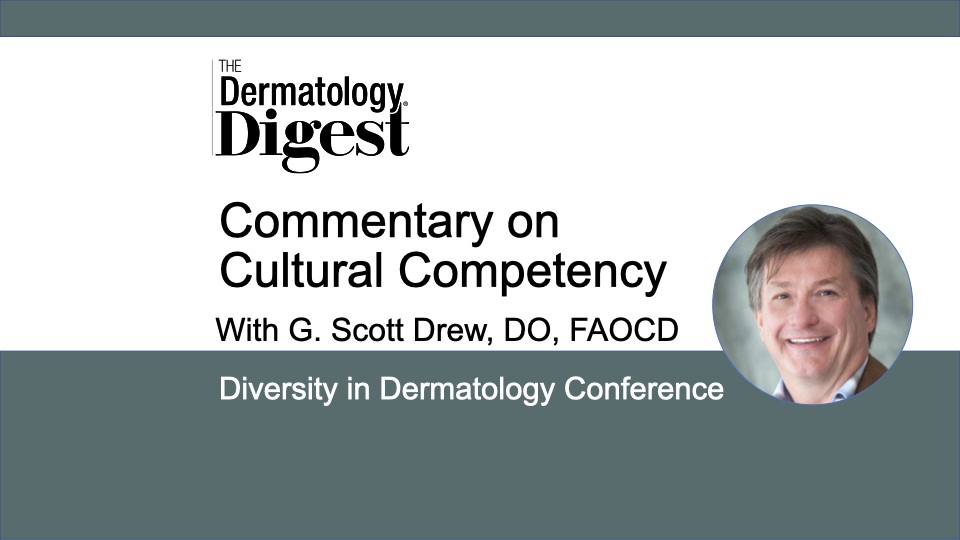Dr. G. Scott Drew discusses the importance of listening to and empathizing with patients of different backgrounds and cultures to understand their priorities within the construct of their disease states.
G. Scott Drew, DO, FAOCD, Board-Certified Dermatologist, Dermatology Associates of Mid-Ohio, Marion, Ohio
“How do I share my old, ambulatory, straight, male, white experience in my world, and how that plays out in cultural competency?” said G. Scott Drew, DO, FAOCD, who presented “Cultural Competency in Healthcare & Dermatology” at this year’s Diversity in Dermatology Conference.
“I’m practicing in Marion, Ohio, which is not exactly diversity central in Ohio,” he said.
While Dr. Drew’s area of specialization is inflammatory dermatology, his avocation is medical outreach, he said, which has provided him with a unique perspective.
“I’ve been on probably 30 medical trips to Uganda, Malawi, Kenya, Nicaragua, Peru, Cuba, Vietnam, India—we’ve been all over the place.”
During the session, there was detailed discussion of vitiligo to illustrate one such cultural consideration, said Dr. Drew.
“[It] doesn’t itch, doesn’t burn, doesn’t bleed, doesn’t kill you; however, [it] can suck the life out of you. If you’re a patient, particularly if you’re Fitzpatrick 6 or 5 or 4 or 3—I mean, also a 1 or 2…the same symptoms, the same pathophysiology, the same genotype and phenotype, same disease—causes vastly different symptoms based strictly on your color and the perception of that.”
Case-in-point, in Malawi, there are separate living communities for those with pigmentary skin disease, said Dr. Drew. Those with vitiligo or albinism have to live in a segregated village.
“So when you get your arms, brain, and heart around that, it makes it a whole lot easier to understand racial disparities.”
Perspective and Empathy
While there is a fairly universal protocol for treating someone who’s having a heart attack, it’s not the same when caring for psoriasis or atopic dermatitis, for example, which have a significant amount physical and psychosocial morbidities, said Dr. Drew.
“So there’s some informed choices that we’re able to make [about] what affects different people relative to their AD or their psoriasis and the cultural realities, surrounding post inflammatory pigment change or areas of lichenification or excoriation.”
For example, itch may be the biggest issue for one AD patient, but it might be color variation for another.
“So I think cultural competency is listening to your patient and understanding what’s important to them in the milieu or in the construct of their disease state.”
For example, in many areas of sub-Saharan Africa, a female patient’s hair may be considered private, and only viewable by her spouse. So the examination, diagnosis, and treatment of an alopecia areata patient takes on a completely different tone than what might be otherwise undertaken.
Unique cultural values and morals are not unique to far off locales. In cities and towns across North America, there are subtle cultural variations that patients hold dear.
A patient’s cultural priorities, “…might not be a big deal to me, but unless I’ve been that patient in that setting , I can’t know what they are going through. So you have to be able to surround yourself with people who have had that experience or listen to people [who] say, this is why it’s a big deal to me.”
According to Dr. Drew, cultural competency isn’t just race, age, gender, location, or diagnosis.
“It’s all a matter of trying to put yourself in the other person’s shoes. Even if I don’t look like, sound like, or talk like the person, it makes a big impact to make an effort to understand.”
In medical school, you’re taught to greet patients with composure and without making assumptions, he said.
“When you go to medical school you’re taught to walk into a room and never judge. Your initial reaction to whatever routine or bizarre presentation is supposed to be, ‘Hi, I’m Dr. Drew, how can I help you?’”
This speaks to making assumptions of any kind related to race, age, or gender, said Dr. Drew.
“Let them tell the story and do your best not to be judgmental. That seems somewhat rudimentary, but one person’s diffuse facial nodulocystic acne, is someone else’s post auricular comedone.”
The bottom line is ears open, mouth closed, said Dr. Drew.
“So just again to listen and to empathize. And with this heightened awareness of people being different from each other, you can do things to make people more comfortable.”


